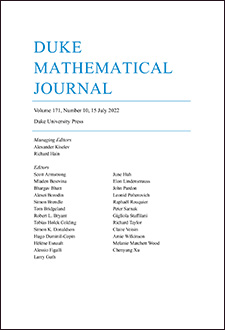Abstract
The moduli space of Riemann surfaces of genus is (up to a finite étale cover) a complex manifold, so it makes sense to speak of its Dolbeault cohomological dimension. The conjecturally optimal bound is . This expectation is verified in low genus and is supported by Harer’s computation of its de Rham cohomological dimension and by vanishing results in the tautological intersection ring. In this article, we prove that such a dimension is at most . We also prove an analogous bound for the moduli space of Riemann surfaces with marked points. The key step is to show that the Dolbeault cohomological dimension of each stratum of translation surfaces is at most . In order to do that, we produce an exhaustion function whose complex Hessian has controlled index: the construction of such a function relies on some basic geometric properties of translation surfaces.
Citation
Gabriele Mondello. "On the cohomological dimension of the moduli space of Riemann surfaces." Duke Math. J. 166 (8) 1463 - 1515, 1 June 2017. https://doi.org/10.1215/00127094-0000004X
Information





